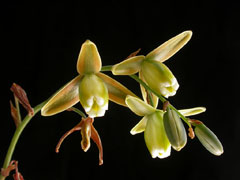 |
|
http://www.plantweb.co.za/ |
 |
|
Translate this page:
Summary
Bloom Color: Yellow.
Main Bloom Time: Early summer, Late spring. Form: Irregular or sprawling.
Physical Characteristics

 Albuca canadensis is a BULB growing to 0.4 m (1ft 4in) by 0.2 m (0ft 8in) at a medium rate.
Albuca canadensis is a BULB growing to 0.4 m (1ft 4in) by 0.2 m (0ft 8in) at a medium rate.
See above for USDA hardiness. It is hardy to UK zone 8. It is in flower in April. The species is hermaphrodite (has both male and female organs) and is pollinated by Insects.
Suitable for: light (sandy) and medium (loamy) soils and prefers well-drained soil. Suitable pH: mildly acid, neutral and basic (mildly alkaline) soils. It cannot grow in the shade. It prefers dry or moist soil.
UK Hardiness Map
US Hardiness Map
Synonyms
Plant Habitats
Cultivated Beds;
Edible Uses
Edible Parts: Stem
Edible Uses:
The succulent stems are chewed to allay thirst[177]. They are rather mucilaginous[2]. This use is listed for A. major, but since this species is so closely related it almost certainly has the same use[K].
References More on Edible Uses
Medicinal Uses
Plants For A Future can not take any responsibility for any adverse effects from the use of plants. Always seek advice from a professional before using a plant medicinally.
None known
References More on Medicinal Uses
The Bookshop: Edible Plant Books
Our Latest books on Perennial Plants For Food Forests and Permaculture Gardens in paperback or digital formats.

Edible Tropical Plants
Food Forest Plants for Hotter Conditions: 250+ Plants For Tropical Food Forests & Permaculture Gardens.
More

Edible Temperate Plants
Plants for Your Food Forest: 500 Plants for Temperate Food Forests & Permaculture Gardens.
More

More Books
PFAF have eight books available in paperback and digital formats. Browse the shop for more information.
Shop Now
Other Uses
References More on Other Uses
Cultivation details
Landscape Uses:Border, Container. Requires a sheltered position in full sun in a light well-drained soil[200]. Succeeds outdoors in areas where frosts are short-lived and light, to a minimum of -5°, and in such areas grow well in a wild or informal garden[200]. It is best to give the bulbs some protection in the winter, preferably using a cloche or pane of glass[1]. This species is closely related to A. major and that species is included here by some botanists[73, 200]. Special Features:
Not North American native, Fragrant flowers.
References Carbon Farming Information and Carbon Sequestration Information
Temperature Converter
Type a value in the Celsius field to convert the value to Fahrenheit:
Fahrenheit:
The PFAF Bookshop
Plants For A Future have a number of books available in paperback and digital form. Book titles include Edible Plants, Edible Perennials, Edible Trees,Edible Shrubs, Woodland Gardening, and Temperate Food Forest Plants. Our new book is Food Forest Plants For Hotter Conditions (Tropical and Sub-Tropical).
Shop Now
Plant Propagation
Seed - we have no details for this species but suggest sowing the seed in a greenhouse in a light well-drained compost as soon as it is ripe if possible, otherwise in spring. Sow the seed thinly so that the young plants can be grown on in the same pot for their first year of growth. Apply a liquid feed from time to time if the seedlings look as though they need nutrients and prick them out at the end of their first growing season. Grow on the plants for at least their next winter in a greenhouse and plant out when the bulbs are dormant in late summer or early autumn. Division of offsets in late summer.
Other Names
If available other names are mentioned here
Native Range
AFRICA: South Africa (Northern Cape, Western Cape)
Weed Potential
Right plant wrong place. We are currently updating this section.
Please note that a plant may be invasive in one area but may not in your area so it's worth checking.
Conservation Status
IUCN Red List of Threatened Plants Status :

Growth: S = slow M = medium F = fast. Soil: L = light (sandy) M = medium H = heavy (clay). pH: A = acid N = neutral B = basic (alkaline). Shade: F = full shade S = semi-shade N = no shade. Moisture: D = dry M = Moist We = wet Wa = water.
Now available:
Food Forest Plants for Mediterranean Conditions
350+ Perennial Plants For Mediterranean and Drier Food Forests and Permaculture Gardens.
[Paperback and eBook]
This is the third in Plants For A Future's series of plant guides for food forests tailored to
specific climate zones. Following volumes on temperate and tropical ecosystems, this book focuses
on species suited to Mediterranean conditions—regions with hot, dry summers and cool, wet winters,
often facing the added challenge of climate change.
Read More
Expert comment
Author
(L.)F.M.Leight.
Botanical References
73200
Links / References
For a list of references used on this page please go here
Readers comment
| Add a comment |
|
If you have important information about this plant that may help other users please add a comment or link below. Only comments or links that are felt to be directly relevant to a plant will be included. If you think a comment/link or information contained on this page is inaccurate or misleading we would welcome your feedback at [email protected]. If you have questions about a plant please use the Forum on this website as we do not have the resources to answer questions ourselves.
* Please note: the comments by website users are not necessarily those held by PFAF and may give misleading or inaccurate information.
To leave a comment please Register or login here All comments need to be approved so will not appear immediately.
|
Subject : Albuca canadensis
|
|
|
|